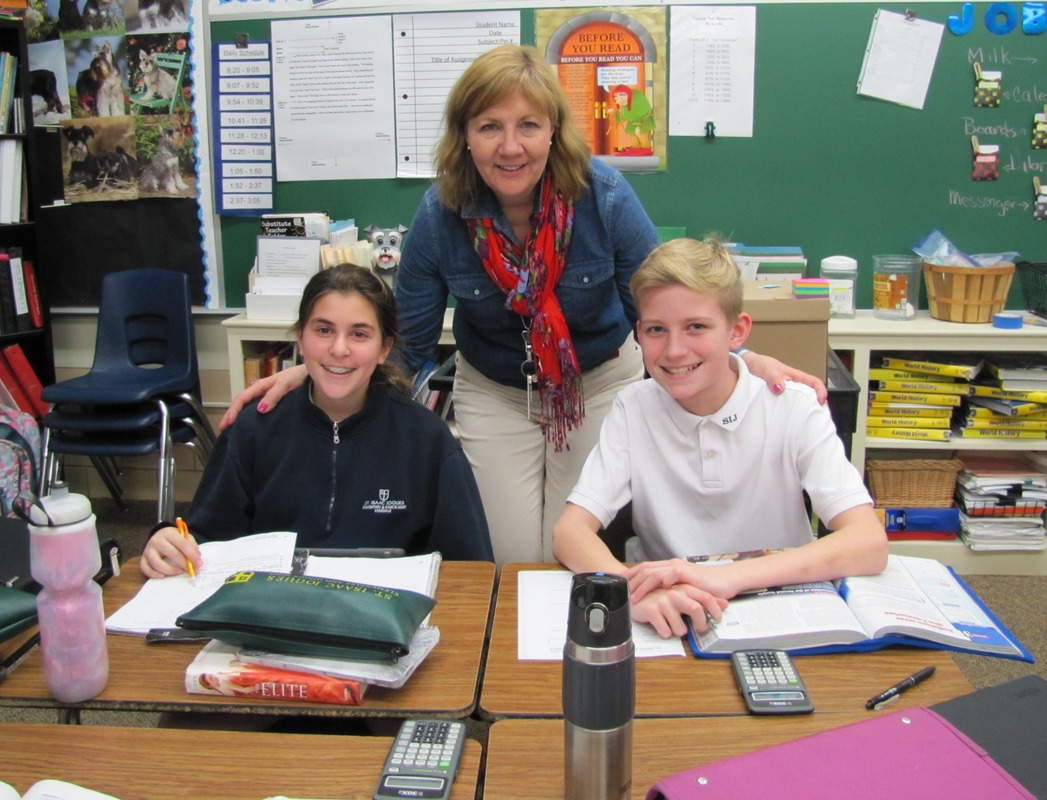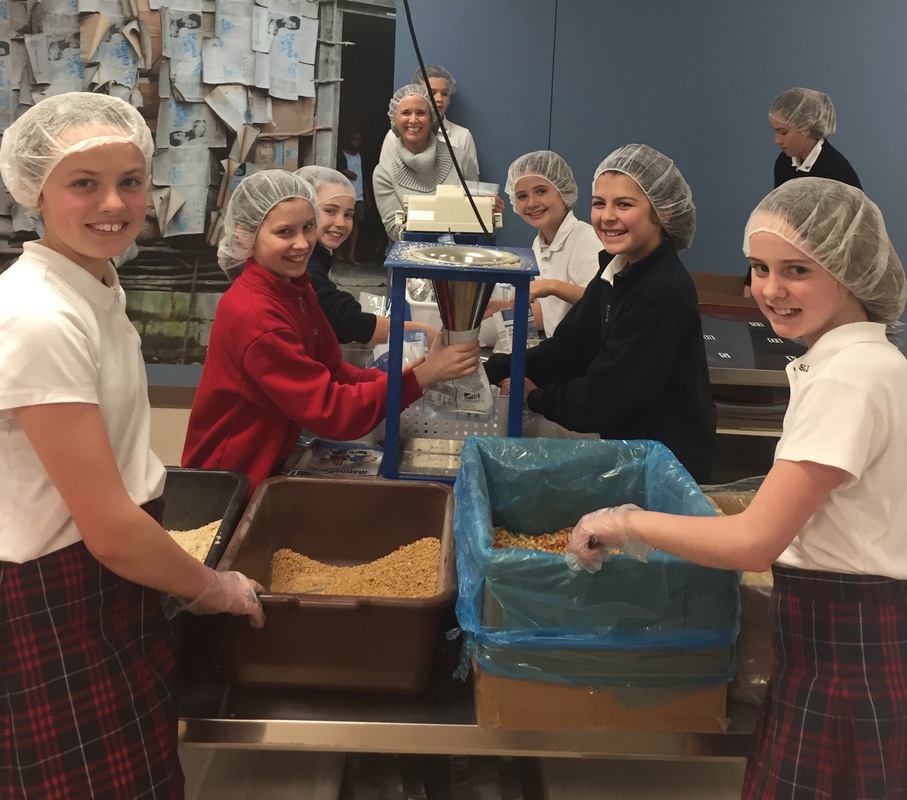6th Grade Curriculum
Religion
Students will learn about the Catholic faith through stories, activities, Scripture, prayer, discussion and reflection. Values are integrated into all aspects of learning. Concepts include a study of:
- The Old Testament/Hebrew Scriptures;
- Bible organization;
- Hebrew scripture;
- Salvation history;
- God’s plan for us; and
- Family Life: students’ life experiences in the church, in the family, in the community.
Language Arts
Our Language Arts program includes reading, writing, speaking, listening, grammar, and vocabulary.
Reading
Read and comprehend multiple genres including fiction, non-fiction and poetry. Application of comprehension strategies including recognizing story structure and text features, summarizing, questioning, the use of graphic organizers and monitoring comprehension.
Through a designated personal reading time students choose high interest books to improve their reading fluency, comprehension and love of reading.
Library and information skills.
Through a designated personal reading time students choose high interest books to improve their reading fluency, comprehension and love of reading.
Library and information skills.
Writing, Language, Speaking and Listening
Writing for various purposes including:
- Narrative writing to develop real or imagined experiences.
- Informative/explanatory writing to convey idea, concepts and information.
- Argumentative/Persuasive Writing with clear and relevant reasons to support their claim.
- A study of the conventions of writing, as well as grammar with a focus on pronouns.
- Collaborates effectively with peers to build on others’ ideas as well as express their own.
- Use of 1:1 digital tools to produce and publish writing.
- Acquires and uses vocabulary based on grade level reading, content, and study of Latin and Greek Roots.
Mathematics
Students will acquire a knowledge of mathematics and applied mathematics to solve problems through text, activities and hands-on experiences. Concepts include a study of:
- formulas, expressions and equations;
- fractions, decimals and percentages;
- graphs and data collection;
- perimeter, area, volume of geometric figures;
- geometry of a plane;
- ratios and proportions;
- number sense, patterns and number theory;
- problem solving in real life situations; and
- models to clarify mathematical concepts.
Social Studies
Students will acquire social, cultural, geographical, linguistic, artistic and educational understanding of the world around them. Concepts include a study of:
- world regions and early cultures;
- River Valley civilizations: ancient Egypt, Mesopotamia, India, China;
- new ideas and empires: ancient Greece, Rome, Arabia, America;
- regions in transition: cultures of medieval Europe, Africa, Asia, America;
- European expansion, French and American revolutions; and
- Geography: oceans, continents, hemispheres, longitude, latitude, continents and countries.
Science
Through the lense of Catholic teaching, students will use a variety of sources including hands-on experiences and 1:1 technology to understand concepts pertaining to Earth Science under the Next Generation Science Standards (NGSS). Students will also apply the Scientific Method through lab experiences and ongoing inquiry. Students will utilize the STEMScopes online resource as well as participate in weekly STEM pre-engineering lessons. In addition, students will incorporate critical thinking skills into reading informational texts and writing lab reports. Concepts include a study of:
- principles of scientific investigation;
- Earth’s place in the universe and astronomy,
- geologic time and the fossil record;
- plate tectonics, earthquakes, and volcanoes; and
- weather and climate
Spanish
Students will continue to learn basic concepts of Spanish by reading, writing, listening and speaking. Concepts include a study of:
- discussing dates and times;
- describing themselves and others;
- talking about likes and dislikes using expressions of “gustar”; and
- exploring Hispanic cultures.
Physical Education
Physical fitness and well being will continue to be encouraged by focusing on refining movement and manipulative skills that encourage a lifelong appreciation for a healthy life style. Concepts include:
- lead-up games and its rules are introduced, team sport skills are reinforced; and
- complex activities which require cooperative behavior are encouraged.
- ball and agility games;
- manipulative skills;
- fitnessgram;
- volleyball;
- long and short jump roping;
- basketball;
- soccer;
- Frisbee games; and
- team challenges.
Art
Students will be able to use all of the elements of design to create various art forms. Concepts include a study of:
- creating colors with value and intensity;
- drawing and painting in a variety of materials with advanced techniques in watercolor and Tempera paint;
- building upon art vocabulary and ability to critique;
- introduction to polymer clay, graphic design and stop-motion animation;
- exploring cave paintings, mapmaking, Egyptian and early Greco-Roman art; and
- using iPads.
Music
Students will learn and develop the concepts of:
- characteristics and functions of music in several cultures;
- exploring musical history and composers;
- singing in groups; and
- using iPads to perform rhythms.
Information Skills
Sixth graders evaluate various sources for information, using established standards for credibility and currency. Students interview local professionals to obtain information. Students continue to develop coding skills. Students read from the Caudill list, identifying personal preferences in author and genre. Students write Letters about Literature, developing and supporting thesis statements about their reading choices. Students will:
- understand the concept of plagiarism and cite sources properly;
- recognize point of view and opinion in various texts;
- understand scope and depth of different sources and utilize them appropriately for research;
- design and draw medals for the SIJ Book Award; and
- self-select books for checkout, developing preferences and stamina for reading independently.
Technology Skills
Students create and innovate via the use of educational Apps in a 1:1 iPad to student environment.
Using the Google Suite for Education (GSFE), students create documents, spreadsheets and presentations. They are introduced to Google add-ons which allow students to incorporate graphics and other multimedia tools into their documents.
Students learn to collaborate through GSFE. This technology in our 1:1 environment teaches students group dynamics, encourages leadership and personal accountability.
Online resources are used to support the research projects across all content areas. This includes World Book, Britannica School, Novelist, and Infoplease.
Critical thinking and problem solving are supported via the use of STEMscopes and the STEM lab which meets once a week.
Digital Citizenship includes lessons from Common Sense Media. These lessons focus on internet safety, cyberbullying & creating a positive digital footprint.
Using the Google Suite for Education (GSFE), students create documents, spreadsheets and presentations. They are introduced to Google add-ons which allow students to incorporate graphics and other multimedia tools into their documents.
Students learn to collaborate through GSFE. This technology in our 1:1 environment teaches students group dynamics, encourages leadership and personal accountability.
Online resources are used to support the research projects across all content areas. This includes World Book, Britannica School, Novelist, and Infoplease.
Critical thinking and problem solving are supported via the use of STEMscopes and the STEM lab which meets once a week.
Digital Citizenship includes lessons from Common Sense Media. These lessons focus on internet safety, cyberbullying & creating a positive digital footprint.
STEM
The Project Lead The Way Gateway Curriculum is an integrated approach to learning that provides cohesive, hands-on learning opportunities that access authentic real-world, applied learning experiences that empower our middle school students to gain the skills they need to thrive in high school and beyond. Our PLTW curriculum empowers our students to discover and explore interests, imagine and design solutions to real-world challenges, and become independent, confident problem solvers. Students apply knowledge and skills from a variety of disciplines that provides a solid foundation in STEM. The arts and STEM complement and balance each other with STEM representing the knowledge, tools, and processes to invent the future, and the arts providing us with our humanity. Essential art and design concepts blended into the PLTW curriculum to ensure a solid understanding of essential design concepts are scientific illustration, modeling, classic elements of design, videography, and photography. In the PLTW Design and Modeling unit, students discover the design process and develop and understanding of the influence of creativity and innovation in their lives. In the Automation and Robotics unit, students will learn about the history and impact of automation and robotics and they explore mechanical systems, energy transfer, machine automation, and computer control systems.
Elements of our Project Lead The Way curriculum include:
Elements of our Project Lead The Way curriculum include:
- an interdisciplinary approach to developing students’ understanding of STEM concepts and the Design Process;
- STEM lab;
- students will learn to think and solve problems as scientists, engineers, technologists, and mathematicians;.
- all students receive instruction that is aligned with the Next Generation Learning Goals and Standards;
- academic concepts are coupled with real world lessons;
- students apply science, technology, engineering, mathematics, and communication skills in context that make connections between school, community, work, and the global enterprise;
- problem-based, project-based, and inquiry based learning and collaborative decision-making;
- inquiry- rich content with scaffold inquiry activities;
- Engineering notebook documentation;
- cross-curricular connections that link reading, communication, and science in every activity;
- white boards used for instructions and presentations;
- iPads are used for research, communication, and learning activities;
- Desktop computers with monitors;
- PLTW online curriculum and resources for content area and reinforcement;
- three dimensional CAD software to enhance mathematics and engineering curricula; students will also use the CAD programs to investigate the art of design engineering;
- safe environment for students to experiment with new ideas;
- learning is measured through PLTW rubrics and assessments which use performance- based formative assessments and summative, content based specific assessments;
- students are expected to collaborate and work in partnerships, teams, and independently on a variety of PLTW activities and projects;
- STEM curriculum purpose is to increase student achievement and workforce readiness in STEM fields by engaging students in innovative science, technology, engineering, and math instruction;
- participation in extra-curricular activities expands learning opportunities in the STEM fields; and
- provide guest speakers who promote awareness and interest in diverse careers in science and engineering.
Resource and Speech/Language Pathology
St. Isaac Jogues School provides on site speech/language and resource services. Curriculum is child specific and designed to meet needs in reading, math and communication skills.





